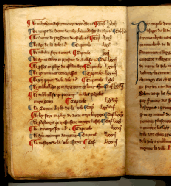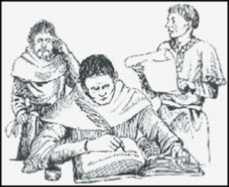


THE DOMESDAY BOOK 1086 (W1)
 xxxxxThis incredible survey of England -
xxxxxThis incredible survey of England -
xxxxxCarried out by eight panels of commissioners and completed in 1086, it covered the vast majority of the country, but Northumberland and Durham were excluded, as also, it would seem, were some of the larger towns, such as London and Winchester. The popular name for this survey -
 xxxxxThe vast quantity of data required was obtained by answers to a long list of questions or by formal meetings in the chief county towns. The names of all landowners, from the highest to the humblest, were listed, together with the size of their land, its ploughing capacity, the number of workers employed, the possession of amenities such as fishponds and mills, and the variety and quantity of livestock held at the time. All was noted down and, more to the point, given a precise value in pounds. Little wonder that there was widespread resentment against this Great Survey,
xxxxxThe vast quantity of data required was obtained by answers to a long list of questions or by formal meetings in the chief county towns. The names of all landowners, from the highest to the humblest, were listed, together with the size of their land, its ploughing capacity, the number of workers employed, the possession of amenities such as fishponds and mills, and the variety and quantity of livestock held at the time. All was noted down and, more to the point, given a precise value in pounds. Little wonder that there was widespread resentment against this Great Survey,
xxxxxThis meticulous survey also revealed the extent of the revolution brought about by the Norman Conquest. By this date only two Anglo-
xxxxxThe Domesday Book -
xxxxxDesigned to calculate what taxes could be levied, and what wealth his barons possessed, the Domesday Book was a remarkable survey of land tenure, stock and farming amenities (such as fishponds and mills), all obtained by a panel of roving commissioners. These men asked questions, made detailed notes, and valued every item recorded. Completed in 1086, the vast majority of the country was covered, but some areas were excluded, along with some of the larger towns. Compiled for the purpose of levying taxes -
Acknowledgement
Commissioners: date and artist unknown.
W1-


